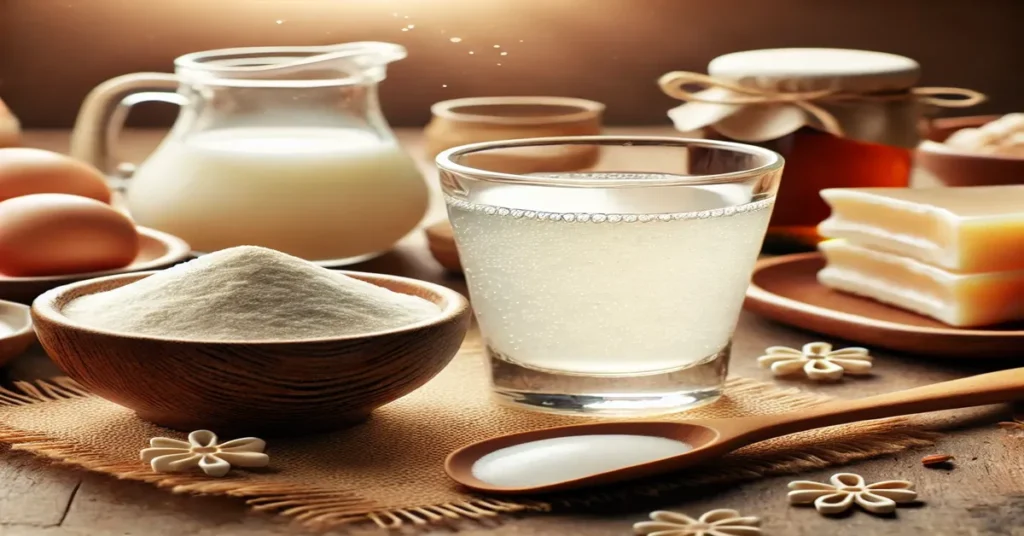Grenetina, commonly known as gelatin, is a versatile ingredient that’s used in a wide range of culinary and non-culinary applications. From giving body to desserts and gummies to its use in pharmaceuticals and cosmetics, grenetina plays an essential role in our daily lives. Derived primarily from animal collagen, grenetina is not only valuable for its functional properties in cooking but also for its numerous health benefits, particularly for skin, joints, and digestive health.
In this comprehensive guide, we’ll explore what grenetina is, how it’s made, its diverse uses, health benefits, and potential side effects. Additionally, we’ll cover ways to incorporate grenetina into your diet and lifestyle, along with frequently asked questions to help you make the most out of this natural product.
What is Grenetina?
Grenetina, or gelatin, is a natural protein obtained from animal collagen, which is the primary protein found in connective tissues, skin, bones, and cartilage of animals. Typically derived from cows, pigs, or fish, grenetina is processed to produce a flavorless, colorless, and odorless powder that can dissolve in warm water and solidify as it cools, forming a gel. This unique gelling property makes grenetina a highly versatile ingredient in both food and non-food industries.
Gelatin is available in two primary forms: powdered gelatin, which is common in home cooking, and gelatin sheets, which are often used by professional chefs for more precise gelling in delicate dishes.
How is Grenetina Made?
The production of grenetina involves a process of extraction from animal collagen, usually from sources such as cow or pig bones, hides, and connective tissues. Here’s a simplified overview of the process:
- Preparation and Cleaning: The animal by-products are cleaned to remove any impurities.
- Acid or Alkaline Treatment: The raw materials are treated with an acid or alkaline solution to break down the collagen and make it easier to extract. The type of treatment used depends on the source of collagen.
- Extraction: The treated material is boiled in water to extract collagen, which is then filtered and purified.
- Concentration: The liquid collagen extract is concentrated by removing water.
- Drying and Grinding: The concentrated collagen is dried and ground into a powder, resulting in the final product – grenetina.
The entire process is carried out in hygienic conditions to ensure the safety and purity of the final product, which is then used in various industries, including food, pharmaceuticals, and cosmetics.
Nutritional Profile of Grenetina
While grenetina is primarily known for its functional properties, it also offers several nutritional benefits. Here’s a breakdown of its nutrient composition:
- Protein: Grenetina is nearly pure protein, with around 85-90% protein content. It contains a unique profile of amino acids, particularly glycine, proline, and hydroxyproline, which are beneficial for skin, joint, and muscle health.
- Amino Acids: The amino acids in grenetina are essential for collagen synthesis in the body. Glycine, in particular, has anti-inflammatory and antioxidant properties.
- No Fat or Carbohydrates: Grenetina is virtually free from fats and carbohydrates, making it an ideal protein source for low-carb or ketogenic diets.
While grenetina lacks some essential amino acids (such as tryptophan), it can still complement a balanced diet when combined with other protein sources.
Health Benefits of Grenetina
Grenetina is more than just a gelling agent; it has several health benefits due to its collagen-boosting properties. Here’s a look at how grenetina can support overall health:
1. Supports Joint Health
Grenetina is rich in amino acids that contribute to joint health. Collagen, which is the primary protein in grenetina, helps maintain the integrity of cartilage, which acts as a cushion between bones. Studies suggest that consuming grenetina may reduce joint pain, stiffness, and inflammation, especially in people with osteoarthritis or athletes who experience joint stress.
2. Promotes Healthy Skin
As a source of collagen, grenetina can improve skin elasticity, hydration, and firmness. Collagen levels naturally decrease with age, leading to wrinkles and sagging skin. Incorporating grenetina into the diet may help slow down this process by boosting collagen production, which can result in more youthful, supple skin.
3. Improves Digestive Health
Grenetina supports digestive health by enhancing the protective lining of the digestive tract. It helps bind water in the stomach, which can aid in food digestion and prevent digestive disorders such as leaky gut syndrome. The amino acid glycine in grenetina also promotes a healthy gut lining, reducing inflammation and supporting overall gut health.
4. Enhances Muscle Growth and Recovery
Grenetina is rich in protein, which is essential for muscle growth and repair. While it may lack some essential amino acids, it still provides a source of dietary protein that can complement other protein sources in a diet. Athletes and those engaged in strength training can benefit from grenetina as a supplement to aid in muscle recovery and reduce post-exercise soreness.
5. Supports Bone Health
The amino acids in grenetina are beneficial for bone health, as they aid in calcium absorption and collagen production in bones. Consuming grenetina regularly may contribute to stronger bones and reduce the risk of fractures and osteoporosis, particularly in older adults.
6. Promotes Better Sleep
Glycine, an amino acid in grenetina, has been shown to promote better sleep by calming the nervous system and lowering body temperature. Consuming a small amount of grenetina before bedtime may improve sleep quality, making it a natural remedy for those who struggle with insomnia or restless sleep.
Culinary Uses of Grenetina
Grenetina’s unique ability to form a gel when dissolved in warm water makes it a valuable ingredient in various culinary applications. Here are some common ways to use grenetina in cooking:
- Jellies and Gummies: Grenetina is the main ingredient in gelatin-based desserts like jellies and gummy candies. It provides the chewy texture that is characteristic of these treats.
- Marshmallows: Homemade marshmallows are made with grenetina’s, which gives them their soft, fluffy texture. These treats can be made with just a few ingredients, including sugar, grenetina’s, and flavorings.
- Panna Cotta: This Italian dessert uses grenetina to achieve a smooth, creamy consistency. Panna cotta is a popular dessert in many cultures, often flavored with vanilla, chocolate, or fruit.
- Mousses and Creams: Grenetina’s is commonly used in mousses and creams to add stability and texture. It allows these desserts to hold their shape while remaining light and airy.
- Savory Dishes: In savory cooking, grenetina’s can be used to thicken sauces, soups, and consommés. It can also be used to create aspic, a dish where meat or vegetables are set in gelatin.
- Smoothies: Adding grenetina’s to smoothies is a great way to increase protein content without altering the taste. It also adds a slightly thicker texture, making smoothies more satisfying.
- Homemade Protein Bars: Grenetina’s can be added to homemade protein bars to improve their consistency and nutritional profile.
Experimenting with grenetina’s in the kitchen opens up endless possibilities for creative and healthy dishes, both sweet and savory.
Non-Culinary Uses of Grenetina
Grenetina’s is also widely used outside the kitchen. Here are some of its non-culinary applications:
- Cosmetics: Due to its collagen content, grenetina’s is used in skincare products like creams, lotions, and face masks to improve skin elasticity and hydration.
- Pharmaceuticals: Grenetina’s is commonly used to create capsules for medications, as it’s easily digestible and dissolves in the stomach.
- Hair Care: Gelatin hair treatments are used to strengthen and nourish hair, improving its shine and thickness.
- Nail Care: Grenetina’s is believed to strengthen nails, making it a popular ingredient in DIY nail treatments.
- Art and Craft: Grenetina’s is used in photography as a binding agent in film and in art supplies for gluing and binding.
Potential Side Effects of Grenetina
While grenetina’s is generally safe for most people, there are some potential side effects and considerations to keep in mind:
- Allergic Reactions: Some people may be allergic to gelatin, especially if it’s derived from certain animal sources. Allergic reactions may include itching, swelling, or digestive discomfort.
- Digestive Issues: In some cases, consuming too much grenetina’s can lead to bloating, gas, or an upset stomach. If you’re new to grenetina’s, start with small amounts to see how your body reacts.
- High Protein Content: Grenetina’s is high in protein, which can be an issue for those with kidney problems or people on a low-protein diet. Consult a healthcare provider if you have concerns about protein intake.
- Vegan and Vegetarian Restrictions: Grenetina’s is an animal-derived product, so it’s not suitable for vegetarians or vegans. There are plant-based alternatives, such as agar-agar, which can be used instead.
- Potential Contaminants: Like any animal product, gelatin may carry a risk of contaminants if not produced under strict quality control. Always choose a reputable brand to ensure purity.
Tips for Incorporating Grenetina into Your Diet
Adding grenetina to your diet is simple, and it can easily be incorporated into various recipes. Here are some tips to get started:
- Start with Smoothies: Add a teaspoon of grenetina to your daily smoothie for a protein boost. It won’t affect the flavor but will add a thicker texture.
- Use in Soups and Sauces: For a nutritious boost, dissolve grenetina’s in hot soup or sauces. It adds protein and helps thicken the liquid.
- Make Homemade Gummies: Create your own healthy gummies with fruit juice, honey, and grenetina’s. It’s a fun way to enjoy grenetina’s, especially for kids.
- Try in Coffee or Tea: Stir a small amount of grenetina’s into your morning coffee or tea. It dissolves quickly in hot liquid and adds a creamy texture.
- Use in Baked Goods: Grenetina’s can be added to baked goods like cakes and muffins for a slight increase in protein content.
- Experiment with Panna Cotta: Try making panna cotta for a delicious, creamy dessert that uses grenetina’s as a key ingredient.
Conclusion
Grenetina’s is a unique and versatile ingredient that offers a wide range of benefits, from improving joint health and skin elasticity to aiding digestion and promoting restful sleep. Its applications extend far beyond the kitchen, making it a valuable resource in cosmetics, pharmaceuticals, and even art. While it’s generally safe and beneficial, it’s essential to use grenetina’s in moderation and be aware of any potential allergies or dietary restrictions.
Whether you’re looking to boost your health, enhance your cooking, or explore DIY beauty treatments, grenetina’s has something to offer. This natural collagen-rich product is a convenient way to incorporate protein and other benefits into your lifestyle, supporting wellness in various aspects of life.
FAQs
1. Is grenetina safe for children?
Yes, grenetina is safe for children in moderate amounts. It’s often used in homemade gummies and treats, making it a fun and nutritious ingredient for kids.
2. Can grenetina help with weight loss?
Grenetina is low in calories and high in protein, which can promote satiety and support muscle growth. However, it should be part of a balanced diet rather than relied on solely for weight loss.
3. What is the difference between grenetina and agar-agar?
Grenetina is animal-based, while agar-agar is plant-based, derived from seaweed. Agar-agar is a popular vegan substitute for grenetina.
4. Can I use grenetina in cold recipes?
Grenetina needs to be dissolved in warm liquid to activate its gelling properties. However, once dissolved, it can be used in cold recipes like panna cotta or cold salads.
5. How much grenetina should I take daily for health benefits?
For general health benefits, around 1-2 teaspoons per day should be sufficient. However, consult a healthcare provider for personalized advice, especially if you have specific health conditions.
6. Are there any vegetarian alternatives to grenetina?
Yes, vegetarian alternatives include agar-agar, carrageenan, and pectin. These plant-based options are suitable for vegetarians and vegans and can be used in similar ways.







